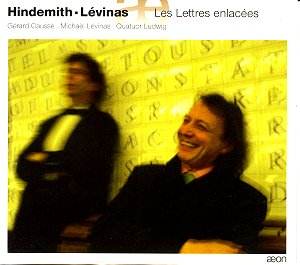Michaël
Lévinas is probably better-known as a brilliant pianist
and untiring champion of new music; but he is also a very distinguished
composer whose music has already been well served by two earlier
Aeon releases entirely devoted to it. In 2000, he composed a group
of works sharing the same title Les Lettres enlacées
("Intertwined Letters") which refers "to a style
of writing based on two melody lines that overlap, pile up, cross
over and finally return to a more or less parallel position"
(the composer’s words).
Thus,
Les Lettres enlacées II for solo viola opens
with a slow introduction out of which a broad melody "in
a canon of micro-intervals on two strings" emerges, goes
on spiralling, with varied restatements of earlier material. When
reaching its conclusion, the music spirals back to silence, this
time, in stratospheric harmonics.
Les
Lettres enlacées IV for string quintet (two violas)
is roughly conceived along the same lines, thus as an infinite
spiral of some sort. Curiously enough (and significantly enough,
I think) the whole work, however, is more homophonic than its
companion for solo viola. Both works are superbly written for
strings, and are readily accessible and communicative, each in
its own way. I did not know any of Lévinas’ music before
reviewing this fine disc; but if the rest of it is of the same
level as the two pieces heard here, I would certainly like to
hear more.
At
first, the pairing of recent works with two early sonatas by Hindemith
might seem a bit far-fetched. Ultimately, however, one easily
comes to the conclusion that Lévinas’ Les Lettres
enlacées II could not have been written without
Hindemith’s own exploration of the many possibilities of his own
instrument. The quite early Viola Sonata Op.11 No.4
was composed after the composer’s release from the army after
the 1918 armistice, and is thus one of the earliest works in which
he still acknowledges some indebtedness to tradition although
the music already displays several Hindemith hallmarks. It is
in three movements (Phantasie, Thema mit Variationen and
Finale mit Variationen) that should be played attaca,
thus emphasis the global conception of the work. The Finale must
thus be experienced as the continuation of the second movement
while the short Fantasy clearly serves as an introduction to what
is essentially a set of variations on a simple, folk-like theme.
The
Viola Sonata Op.25 No.1 for solo viola is a more
mature and more personal achievement displaying Hindemith’s formal
command and instrumental mastery. It is in five movements, of
which the third and fifth ones (both slow) are – significantly
enough – the weightiest in terms of musical substance. The short
fourth movement is a devilish Scherzo to be played with rough,
wild energy. The composer even mentions that the beauty of tone
is secondary; but rest assured, there is nothing ‘ugly’ either
in the music or in Caussé’s superb playing.
This
thought-provoking release deserves the highest praises for the
quality of the music, the immaculate performances and the high
production standards. Gérard Caussé is a wonderful
musician whose technical skills and musicality always pay high
dividends. He is superbly partnered by Lévinas in Hindemith’s
early sonata whereas the quintet gets as fine a reading from Caussé
and the Quatuor Ludwig as possible.
Hubert
Culot
